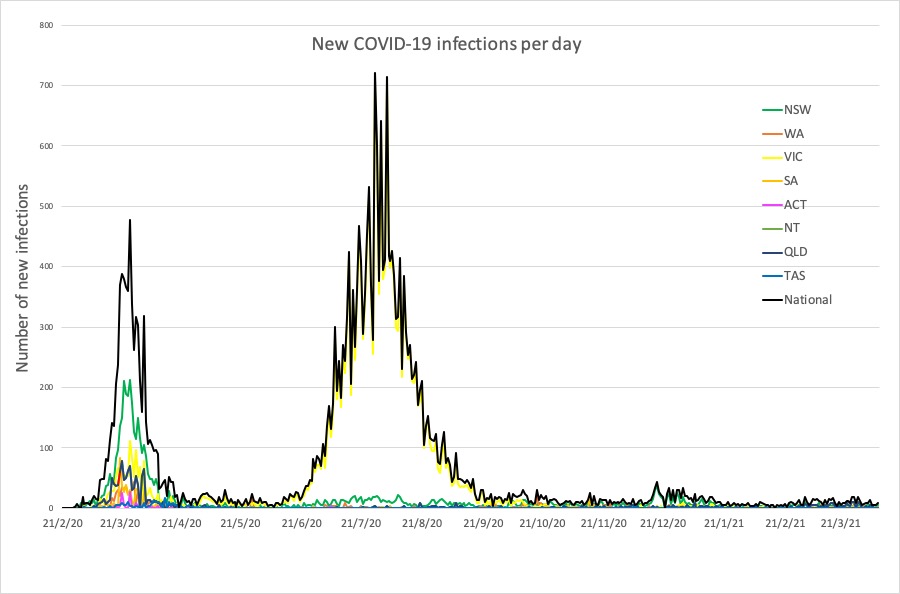And rare clotting side effect linked to AZ vaccine resembles autoimmune thrombocytopenia.
Welcome to The Medical Republic’s COVID Catch-Up.
It’s the day’s COVID-19 news in one convenient post. Email bianca@biancanogrady.com with any tips, comments or feedback.
12 April
- Australia makes greater commitments to help regional nations with COVID-19 vaccine donations.
- Rare blood clot side effect from AZ vaccine resembles autoimmune heparin-induced thrombocytopenia, study finds.
- Swabs from SARS-CoV-2-positive children show lower viral loads and less live virus.
- Latest COVID-19 infection numbers from around Australia.
Australia is planning to share at least 10,000 doses of Australian-manufactured AstraZeneca COVID-19 vaccine per week with countries such as Papua New Guinea, Timor-Leste, Fiji, Vanuatu and the Solomon Islands.
According to a press release from the Minister for Foreign Affairs, Senator Marise Payne, Australia is working with the World Health Organisation and UNICEF to ensure the vaccines get to where they are needed. Australia has committed $623.2 million to a vaccine initiative for the Pacific and Southeast Asia, and also donated $80 million to the international COVAX initiative, which is supplying vaccines to developing nations.
However a report by the Associated Press suggests the COVAX initiative is struggling with global vaccine supply shortages, which are having a disproportionate impact on developing nations.
In the past two weeks, fewer than two million COVAX-supplied vaccine doses were delivered to 92 countries in the developing world, which is around the same number of doses injected in Britain alone over that same period.
WHO Director General Tedros Adhanom Ghebreysus has criticised the inequity of vaccine deliveries, pointing out that around one-quarter of the population of rich countries had received a dose of a COVID-19 vaccine compared to only around one in 500 people in poorer countries.
Thrombotic thrombocytopenia after receiving the AstraZeneca COVID-19 vaccine resembles severe autoimmune heparin-induced thrombocytopenia – a well-known prothrombotic disorder – according to a study of 11 patients who experienced the rare side effect.
A case series published in the New England Journal of Medicine examined the features of 11 cases of thrombotic thrombocytopenia reported one to two weeks after vaccination.
Nine were women, their ages ranged from 22 to 49 years, and they presented with unusual thrombosis, including pulmonary embolism cerebral venous thrombosis and splanchnic-vein thrombosis. Five patients had more than one thrombotic event, and one patient died from cerebral haemorrhage.
None of the patients had previously been treated with heparin, but serology done on four of the patients revealed strong reactivity to PF4–heparin, which the authors described as a ‘striking abnormality’.
“Given the parallels with autoimmune heparin-induced thrombocytopenia, anticoagulant options should include nonheparin anticoagulants used for the management of heparin-induced thrombocytopenia, unless a functional test has excluded heparin-dependent enhancement of platelet activation,” they wrote.
Nasopharygneal swabs taken from children who have tested positive to SARS-CoV-2 showed lower viral loads, suggesting they represent a smaller risk of transmission, researchers say.
A paper published in the Canadian Medical Association Journal reports the outcomes of a study of 305 nasopharyngeal samples positive for SARS-CoV-2, 97 of which were from children aged 10 or under, 78 from children aged 11-17 and the rest from adults.
The samples taken from children were around half as likely to be able to culture live virus as those taken from adults, and had significantly lower viral loads and less live virus.
“These data, along with our local epidemiology, suggest that children do not appear to be the main drivers of SARS-CoV-2 transmission,” the authors wrote.
Here are the latest COVID-19 infection numbers from around Australia to 9pm Sunday:
National – 29,405 with 909 deaths
ACT – 123 (0)
NSW – 5330 (6)
NT – 112 (0)
QLD – 1502 (0)
SA – 666 (1)
TAS – 234 (0)
VIC – 20,485 (0)
WA – 953 (2)



